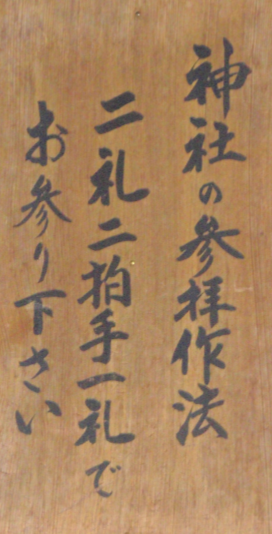7. The "Two" Radical: 二
Things couldn't get much simpler in the radical world than 二. It's a two-stroke radical, which is appropriate for a radical meaning "two." It's pronounced に, with no variations on that theme.

Photo Credit: Ulrike Narins
Here we have the following phone number:
電話 (でんわ: phone)
二二 五一一四 (22-5114)
An Unvarying Shape: 二
Supposedly, the 二 shape has a variant in which the strokes become shorter, but that's not true in any of the Joyo kanji containing this radical:
二 (61: two)
五 (19: five)
亜 (997: sub-; phonetic ア)
互 (1236: reciprocal)
井 (1470: well; town)
 |
In this sign from a Shinto shrine, we see 二 twice in the middle column: 二礼 (にれい: 2 bows) The 拍手 refers to clapping one's hands in prayer. Here are the words from the first column: 神社 (じんじゃ: Shinto shrine) And the words from the last column: 参る (まいる: to visit a shrine (honorific)) When you visit a shrine, please observe the proper etiquette by bowing twice, clapping twice, and then bowing a final time.
Photo Credit: Eve Kushner |
Etymologies of Kanji with the 二 Radical
The most unexpected thing about 二 is that it appears at all in the kanji other than 二 itself. For instance, since 2 doesn't go into 5, it's funny to find 二 inside 五! Nor is there anything representing "two" in the other characters.
Here are Henshall's basic etymologies, with details left for another time:
二 (61: two)
This is a pictograph of two extended fingers.
五 (19: five)
Although people originally represented this with five horizontal strokes, which again symbolized five fingers, the ancient Chinese swapped that for a pictograph of a "thread spool." People used to use their hands when winding yarn, and a spool took the place of that. Why not have the same substitution occur in the world of written characters, as well?!
亜 (997: sub-; phonetic ア)
This character originally represented an underground dwelling with a central chamber and passages or smaller rooms on either side. Over time, 亜 acquired other meanings, such as "hunchback"! But in any case, it has nothing to do with "two."
互 (1236: reciprocal)
Much like 五, this is a pictograph of a "thread spool," though it's a more specialized, complicated spool than 五.
井 (1470: well; town)
According to Henshall's newer edition, this is a pictograph of the square "frame" around a Chinese or Japanese well, the ledges on which one would rest a bucket.
It's purely a matter of convenience that 二 is the radical in any of these cases, aside from the 二 kanji itself. That is, the characters had to go in some radical category, and 二 seemed the best fit, simply because one can spot those parallel strokes in 五, 亜, 互, and 井.
 |
At a shrine, this portion of a sign mentions a significant date: 昭和 (しょうわ: Showa era, 1926–1989) The 26th year of the Showa era was 1951. Anyway, this sign enables us to see 二 and 五 together, as well as several other kanji that have parallel horizontals but that don't qualify as having the 二 radical.
Photo Credit: Yoshikazu Kunugi |
